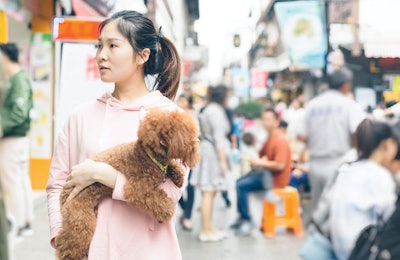
As China counted down to of the year of the ox in February 2021, the year 2020 officially came to an end. Against the overall market downturn from the global pandemic, China’s pet food industry bucked the trend with notable growth. This article offers five observations that sum up the Chinese pet food industry in 2020 and how local pet food businesses and experts view 2021.
1. Competitive landscape is fragmented, with low market concentration
The Chinese pet food market has low concentration and is highly competitive. Imported brands dominate the market but are facing growing challenges from domestic pet food producers. The latter show a superior ability to vertically integrate the supply chain and apply an indirect strategy to penetrate the market, but to date lack the strength to overtake the market as recognized brands.
Unlike the global top 10 pet food brands mainly controlled by conglomerates such as Mars Petcare, Nestlé Purina PetCare and Colgate-Palmolive (Hill’s Pet Nutrition), China’s major domestic brands belong to various manufacturers. The top three-ranking brands of the Chinese dog food market comprised only 15% of sales, and those of the cat food market sat at 16.2%, according to Euromonitor. In comparison, for a mature market like the U.S., the top three brands had a 53% share and 35.8% share, respectively, in the same period.
2. Domestic pet food brands are rising
2020 witnessed the rise of domestic pet food brands in China on all fronts, including supply chain integration, global strategical planning and movement into the high-end pet food market. For example, Yantai China Pet Foods partially put into operation Asia’s highest-end wet pet food factory with an annual full production capacity of 30,000 tons. The Shandong-based company also kicked off the construction of a 5.0 intelligent dry food factory project and acquired PFNZ, the largest pet canning factory in New Zealand.
The domestic companies also invested heavily in setting up novel retail channels, especially online. In contrast to foreign brands such as Royal Canin and Whiskas, which enjoyed strong offline distribution channels backed by high penetration into retail groups, the domestic players leveraged e-commerce to reach consumers directly. Taking the pet sales of the four major e-commerce platforms—Taobao, Tmall, JD and Pinduoduo—as a sample, the six pet food brands with the highest sales were Royal Canin, Myfoodie, Crazy Doggy, Pure Natural, Bridge and Pedigree. Four of those are domestic brands.
In addition, domestic pet food companies shifted their focus to building brand awareness and loyalty with end consumers. Myfoodie, a brand ranked third in the market, applied a pan-entertainment marketing strategy and sponsored a series of high-profile TV programs, successfully reaching middle-class consumers and conveying brand value.
Crazy Doggy, which follows Myfoodie in market share, aimed at winning over novice pet owners and the market of the third- to fourth-tier cities. With the best value-for-money position, the brand recorded high sales growth in e-commerce channels across the major platforms.
Pure Natural, on the other hand, directed its focus to ultra-high-end natural pet food segmentation, working closely with pet shops and pet clinics to set its brand image. The brand now ranks among the top 10 in the Chinese pet food market.
3. Favorable import policies led to significant increase in number of imported brands
As of December 31, 2020, the Ministry of Agriculture and Rural Development approved and registered 715 foreign pet products, including 289 SKUs of cat food, 389 SKUs of dog food and 30 SKUs of other general products for dogs and cats. A total of 21 countries/regions applied for registration of pet compound feeds, with Canada having the highest number of applications at 115 SKUs, followed by New Zealand with 104 SKUs, accounting for 11.8% and 10.6%, respectively.
In 2020, 27 pet food production facilities from the U.S. were newly registered on the list of Chinese government-approved facilities, according to the General Administration of Customs People’s Republic of China. There were another 12 Dutch companies and 10 Italian companies completing the registration and ready to enter the market.
The growing interests of foreign brands were further enhanced by the order of the Tariff Commission of the State Council, which reduced the tax rate on retail packaged and canned dog or cat food from 15% to 4%. The order entered into effect on January 1, 2021.
4. Pet population continued to grow in 2020, fueling market growth
According to data released by the Chinese Pet Industry White Paper 2020, the number of dogs and cats in urban areas nationwide increased by 1.7%, surpassing 100 million for the first time. The number of cats grew to 48.62 million, up 10.2% from 2019, and 52.22 million dogs were recorded, down 5.1%.
In 2020, there were 1.74 million new pet owners in China, bringing the total number to 63 million. Among them, 35.93 million are dog owners, with 1.5 pet dogs per household, and 27.01 million are cat owners, with 1.8 pet cats per household.
In tandem, the market size of the pet industry continued to grow, reaching US$32 billion, according to the white paper, up 2% from 2019. Of that market total, pet food accounted for 55.7% as of 2020, down from 61.4% in 2019. The cat food market showed the strongest growth at 13.3%, while the dog food market declined by 5.1%.
Compared to countries such as the U.S. and Japan, the average number of pets per household in China is still low, but the percentage of pet-owning households is growing rapidly. The domestic 2020 pet penetration rate of 19% is lower than Japan and Korea at 26-27%, and the U.K. and U.S. at 44% and 67%, respectively.
5. Consumption of pet food is diversified
While pet food continued to account for the majority of the Chinese pet industry, the fastest-growing sectors were veterinary care and pet accessories, which increased by 6.2% and 0.9% respectively, said the Chinese Pet Industry White Paper 2020.
Due to the impact of the pandemic, there was a 2% decline in sales in the high-end pet food market compared to 2019. Dog owners were more price sensitive and recorded a larger decrease, while the change among cat owners remained insignificant.
Yet the humanization of pets in China drove pet food consumption upgrades, with the retail unit price of pet food increasing to US$5.1/kg in 2019, which was a 24% increase compared to US$4.15/kg in 2015, according to a Kaiyuan securities report.
















